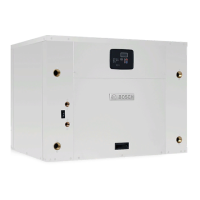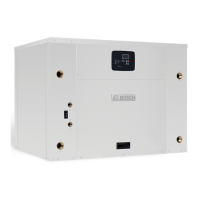6 720 220 046
Revised 05-12
13
TA Series
with the compressor. As the thermostat is satis ed,
the heaters will shut off as soon as W1 is de-
energized, and the compressors will remain on until
the thermostat stages are satis ed. Note that if the
unit compressor lock out for any reason at this time,
the electric heaters will continue to function normally.
Once the thermostat is satis ed, the compressor
shuts down and the fan ramps down either fan only
mode or off over a span of 30 seconds. If emergency
heat (W2/EM) is called for, the fan will ramp up to
emergency heat air ow immediately and the heater
package will energize in emergency heat mode, all
heater elements coming on. On shut down the fan
will ramp down over a period of 30 seconds.
WELL WATER SYSTEMS
(Figure #10)
Copper is adequate for ground water that is not high in
mineral content. Should your well driller express concern
regarding the quality of the well water available or should
any known hazards exist in your area, we recommend
proper testing to assure the well water quality is suitable
for use with water source equipment. In conditions
anticipating moderate scale formation or in brackish
water a cupro-nickel heat exchanger is recommended. In
well water applications water pressure must always be
maintained in the heat exchanger. This can be
accomplished with either control valve or a bladder type
expansion tank. When using a single water well to supply
both domestic water and the heat pump care must be
taken to insure that the well can provide suf cient ow
for both. In well water applications a slow closing
solenoid valve must be used to prevent water hammer.
Solenoid valves should be connected across Y1 and
C1 on the interface board for all. Make sure that the
VA draw of the valve does not exceed the contact
rating of the thermostat.
INSTALLATION OF PRESSURE
REGULATING VALVES
Pressure regulating valves are used to increase or decrease
water ow through the heat pump in response to
refrigerant pressure. In some cases more water may be
required in heating than in cooling, or vice versa. With the
Bosch heat pumps these valves are not required. However,
if installed, a pair of valves are required for proper
operation, one valve for cooling (direct acting) and another
Cooling Mode
Figure #8 for heater package compatibility with speci c
CE Series units, models nomenclature and electrical
data.
Units supplied with internal electric heat require
two (2) separate power supplies: one for the unit
compressor and one for the electric heater
elements, blower motor and control circuit. Refer to
Figure #8 for wiring instructions, minimum circuit
ampacities and maximum fuse/breaker sizing.
The Electric Heater Kit for Horizontal models
have to be installed before the unit is installed.
SEQUENCE OF OPERATION–
TWO STAGE UNITS
(Figure #13 Wire Schematic)
COOLING MODE
Energizing the “O” terminal energizes the unit reversing
valve in the cooling mode. The fan motor starts when
the “G” terminal is energized. Note that the fan motor
will take 30 seconds to ramp up to operating speed and
will run at fan only rated air ow as long as there is no
call for compressor or heater operation.
When the thermostat calls for rst stage cooling (Y1)
the loop pump or solenoid valve if present is
energized and the rst stage of compressor capacity
starts. The fan ramps up to rst stage cooling air ow
in 30 seconds.
When the thermostat calls for second stage cooling
(Y2) the second stage (or full compressor capacity)
is initiated. The fan ramps up to full cooling air ow.
Once the thermostat is satis ed, the compressor shuts
down accordingly and the fan ramps down to either fan
only mode or off over a span of 30 seconds.
Note that a fault condition initiating a lockout
will de-energize the compressor irrespective
of which stage is engaged.
HEATING MODE
The rst two stages of heating (Y1 & Y2) operate in
the same manner as cooling, but with the reversing
valve de-energized. On a call for auxiliary heat (W1),
the fan ramps up to auxiliary heat air ow immediately
and the electric heater package is energized along

